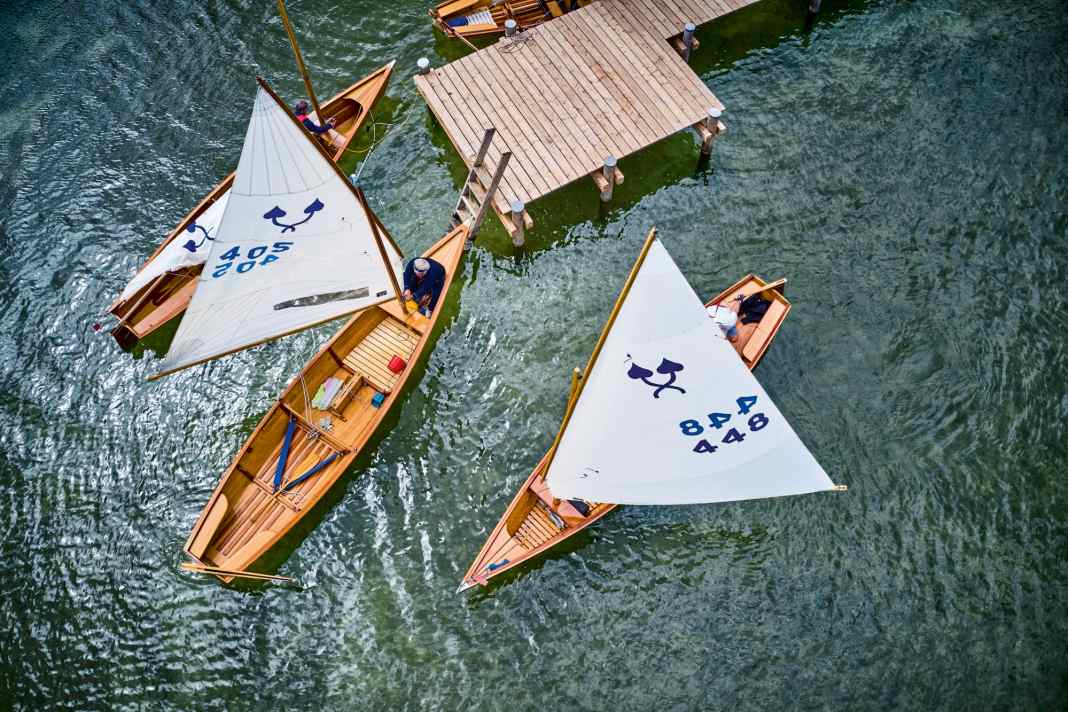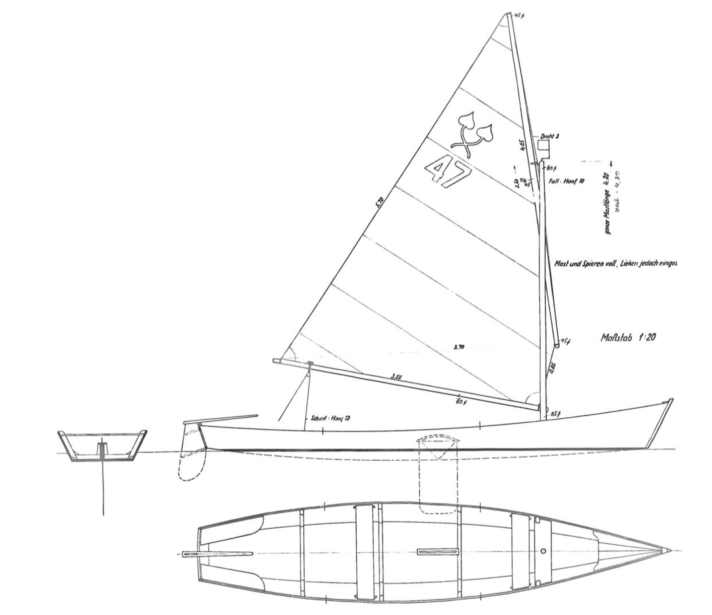





The wind on the lake blows strongly at four Beaufort from the edge of the Alps and conjures up white crests of foam on the dark green surface of the water. In the middle of this breathtaking panorama, a small white dot glides over the waves: a traditionally planked wooden boat with a lugger sail, ploughing quickly through the churning water. In the background, the mountains rise majestically into the sky, giving the scene an almost monumental setting. What at first glance looks like the description of a romantic landscape painting is reality in the 21st century. Because what is elegantly whizzing across the water is a Chiemseeplätte - a class of boat derived from the fishing and labour boats that were once used by locals on the Upper Bavarian lake.
That is also interesting:
"A sublime sight!" enthuses Matthias Gebauer. He himself is the owner of a Plätte and Chairman of the Chiemseeplätte Class Association. The fleet comprises over 200 boats. At the Chiemsee Yacht Club Prien, a centre of the scene surrounding the historic boat, an extremely lively regatta culture is cultivated today as it was then. "At first glance, the Chiemseeplätte is often misjudged and underestimated. Many people think it's just an old wooden boat," explains Gebauer. "But once you take the tiller, you immediately realise how much finesse, dynamism and elegance there is in this construction."
The steep rise of the Chiemseeplätte came as a surprise
The 6.30 metre long flatboat has a slim hull with a width of 1.40 metres. It is traditionally clinkered or carvel-planked. A ten square metre lugger sail made of natural-coloured cotton or white polyester is rigged on the unstayed mast. Sail battens or a headboard are just as frowned upon as trim, modern fittings or high-tech materials. Ready to sail, the Chiemseeplätte only weighs between 190 and 220 kilograms. It can also be rowed - its original mode of propulsion - and gets going surprisingly quickly.
"Flat sailors are individualists. They don't want plastic, aerodynamic shapes or ultra-modern fittings. They love the beautiful wood and the simple elegance of this ancient class of boat," says Gebauer. And Daniel Kohl, who has been sailing a Chiemsee Plättte on Lake Tegernsee for eight years, adds: "Plättesegeln is a sporty, sometimes acrobatic endeavour. You need a lot of sensitivity and experience to really master this boat."
As a former squad sailor, he should know. Kohl has competed in numerous regattas and championships in various boat classes, most recently in the Star boat. "Similar to the Star boat, sailing with the Chiemseeplätte is very direct - sailing in its purest form. Mistakes are not forgiven. Even the smallest change to the sail or rudder has an immediate effect and is rewarded or penalised within fractions of a second," says Kohl.
"Many people think it's an old wooden barge. But once you steer the tiller, you can feel the dynamism and elegance of this design."
The steep career from regional fishing and work boat to popular regatta boat was by no means predetermined. However, the founding of the Chiemsee Yacht Club in 1913 gave sailing on the lake a powerful voice - and the Chiemseeplätte an influential mentor. The Plätten were already widespread in the area at that time. Originally designed as rowing boats for fishermen, they were gradually remodelled: They were fitted with wooden outboard centreboards and rigged with a simple lugsail. Depending on the size of the sail, they competed in regattas in the A, B or C class. The first boats were fitted with metal centreboards as early as the beginning of the 1930s. They were also given a ten-square-metre rig with a steeper gaff to improve their upwind performance. However, this also increased the differences in performance within the fleet. The comparability of sailing skills decreased. This led to calls for a standardised class. After numerous club meetings and discussions, it was created.
The renaissance came quietly
Basically, it was a real pioneering achievement that the sailing clubs on Lake Chiemsee - above all the first chairman of the Chiemsee Yacht Club at the time, Captain Eugen von Beulwitz - set in motion in 1932: "The Chiemseeplätte is practically the mother of all dinghy unit classes," explains Gebauer, who has intensively studied the original documents in the club archive. The new standardised boat had to be affordable in order to attract as many owners as possible to the sport of sailing. At the same time, it had to be a practical boat that would also be convincing in everyday touring sailing.
"You can talk about a pioneering achievement: The Chiemseeplätte is the mother of all single dinghy classes."
Boat builder Franz Madl and engineer Sepp Holzmayer presented the first official flatboat plan in 1932. Apart from a minor adjustment in 1954, it has remained largely unchanged to this day. YACHT devoted a detailed article to the design in 1933 (issue 31), including a description and dimensional sketch.
The concept of the "unity makers" worked: The Chiemseeplätte developed into one of the most popular regatta classes of all. Until the early 1960s, it was the strongest and most widespread boat class on the lake. After that, however, enthusiasm for the traditional flatboat waned noticeably. Instead of over thirty boats at the starting line as in the past, only eight to ten appeared at regattas. Even contacts with sailing friends on neighbouring Lake Starnberg, where the Plätte was also held in high esteem, could not stop the decline.
The renaissance came quietly. A new appreciation for tradition, the rediscovery of wood as a building material, increased prosperity and, last but not least, the desire for an uncomplicated way to get out on the water and sail regattas in direct comparison and without having to calculate fees - all of this contributed to the revitalisation of the Chiemseeplätte around three decades ago. Impressive proof of this: the number of entries for the Lindchen Cup: over 70 boats took part in 2001. Three years ago, it was recognised as an extraordinary member by the German Sailing Association.
Traditional boatbuilding business on the Fraueninsel
Meanwhile, discussions about construction plans, weight and sail area continue apace. Whether at class association meetings, regattas or sundowners on the lakeshore, the question of how much "original" is in each boat and what can be changed is a regular topic of conversation. It's great proof that even such a simply constructed, puristically equipped boat can spark a lot of passion.
Incidentally, the first standardised boat commissioned by the Chiemsee Yacht Club was built on Fraueninsel in 1933 and christened "Chiemo". Traditional boat building is still practised on the famous monastery island today: Peter Heistracher continues to build the Chiemseeplätte there - alongside elegant motorboats. He uses numerous types of wood for construction: spruce, larch, pine - also known as pine or spruce - red cedar, gabon, mahogany and mahogany-like woods, cambala (iroko) and oak. The wall thicknesses and cross-sections are adapted to the specific weights of the wood species. Some boat builders even select the trees for their boats themselves in their local forest. With a trained eye, they can recognise whether the required seven-metre planks can be extracted from a trunk.
The construction of a small-series Chiemseeplätte takes around 150 hours of labour for the hull alone. "A large proportion of this is spent on the paintwork - especially on the interior," explains Heistracher. "Unfortunately, there are a lot of corners there."
In the past, the fittings were made of galvanised iron or steel, screws were made of brass or galvanised, and the rivets were usually made of copper. Today, stainless steel and aluminium are mainly used. Gluing is no longer done with traditional boatbuilding glue, but with epoxy resin. Modern materials such as carbon fibre, titanium or high-tech plastics remain taboo - in keeping with the class rules and the traditional appearance of the boat.
"Schnürl-Zupfn" on the Chiemsee plateau
Heistracher's shipyard does not currently have any newbuilds on order, but every year, several boats are overhauled and prepared for surveying. "A well-ventilated tarpaulin that extends to the waterline is important for storage on land," emphasises the shipyard manager. "A hall or garage is the ideal location." The cost of a new boat ready to sail is currently between 25,000 and 30,000 euros. Used boats are available for around 7,000 to 10,000 euros, depending on their condition.
Not an inexpensive boat for this size. But in return, new owners get an aesthetic eye-catcher and a versatile "tool of the trade" that also inspires top sailors. "The direct feedback while sailing is enormously training," explains former squad sailor Daniel Kohl. The Chiemsee sailors tongue-in-cheek call the fine-tuning of the sail trim "Schnürl-Zupfn" - a charming paraphrase for the sensitive adjustment of sheet and sail.
Due to the very low freeboard, water quickly comes over even in light swell. As the boats do not have a self-bailer, the water has to be scooped up with a bailer - traditionally with a wooden scoop, the "Sess", which is specially approved for flat-bottomed boats. On a downwind course, the old hands can be seen scooping up water that they have caught on the way to the windward mark. This is because it has to come out again quickly - buoyancy aids are not permitted in the flat boats according to the class regulations.
"The boat can be made to glide and, with a little experience, can be sailed stably over the waves," says Kohl, describing the sailing characteristics. "And you can also reach a considerable height in the wind." Class leader Gebauer confirms the potential of the Chiemseeplätte: "Some helmsmen who were later successful in national and international classes learnt the basics of tactics and technique for regatta sailing in the Plätte. And conversely, top sailors have found their way back to the Plätte in their retirement."
Ready to sail in ten minutes
There is another argument in favour of the speedy fishing boat: the scarce shore space on lakes in southern Germany and near the Alps has always been a problem for water sports enthusiasts. A permanent berth on a jetty or in a buoy field is like winning the lottery. This is where the Chiemseeplätte comes in handy. A slip ramp is all you need to get the trailerable boat into the water and set sail.
The boat and rigging remain protected under the tarpaulin, the sail remains attached and the mast is set. The trailer can be brought to the ramp by hand - the charming sailboat is ready to go in around ten minutes. "Those are unbeatable arguments," says Daniel Kohl. "Even after a day at work, I can spontaneously get out on the water for an hour - without having to go to a lot of trouble."
And once the lake is as smooth as glass, you can go out on oars, just like a hundred years ago - for a round trip, a swim or a picnic on the water.
Technical data of the Chiemseeplätte

- Construction: Franz Madl/Sepp Holzmayer
- Year of origin: 1932
- Length: 6,30 m
- Width: 1,40 m
- Weight (ready to sail): 190-220 kg
- sail area: 10 m²
- Mast height: 4,20 m
- Class association: chiemseeplaette.com

